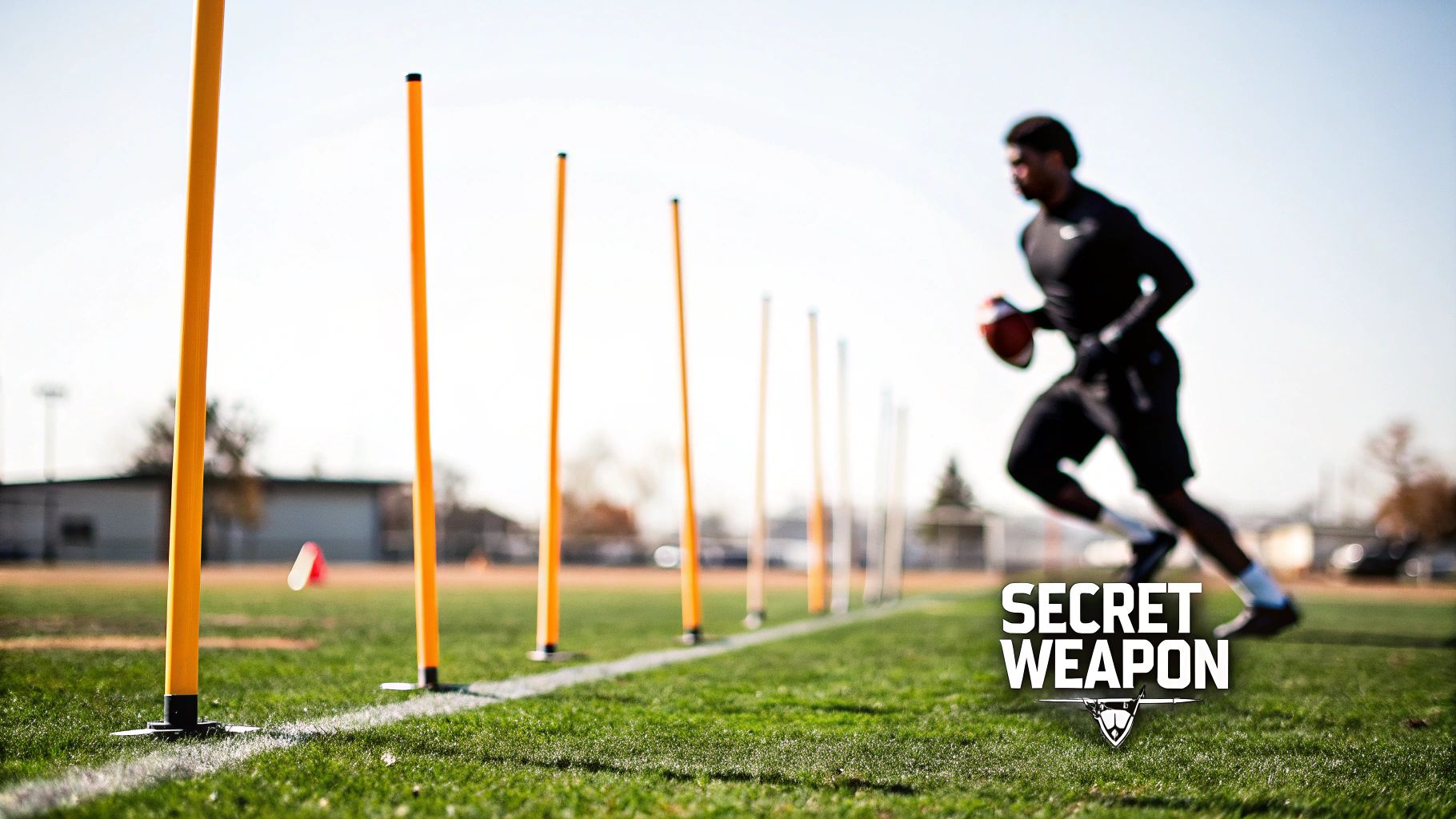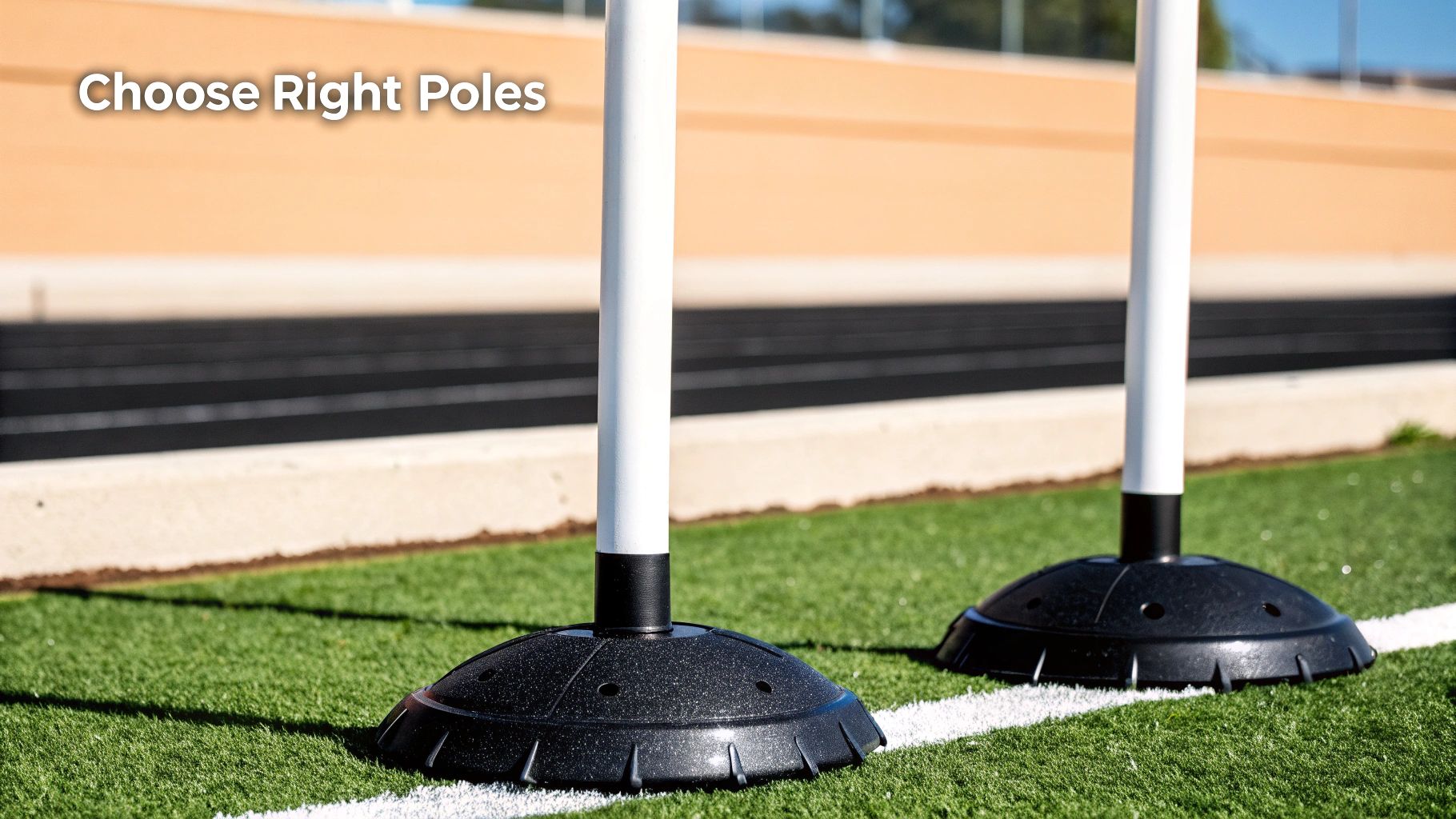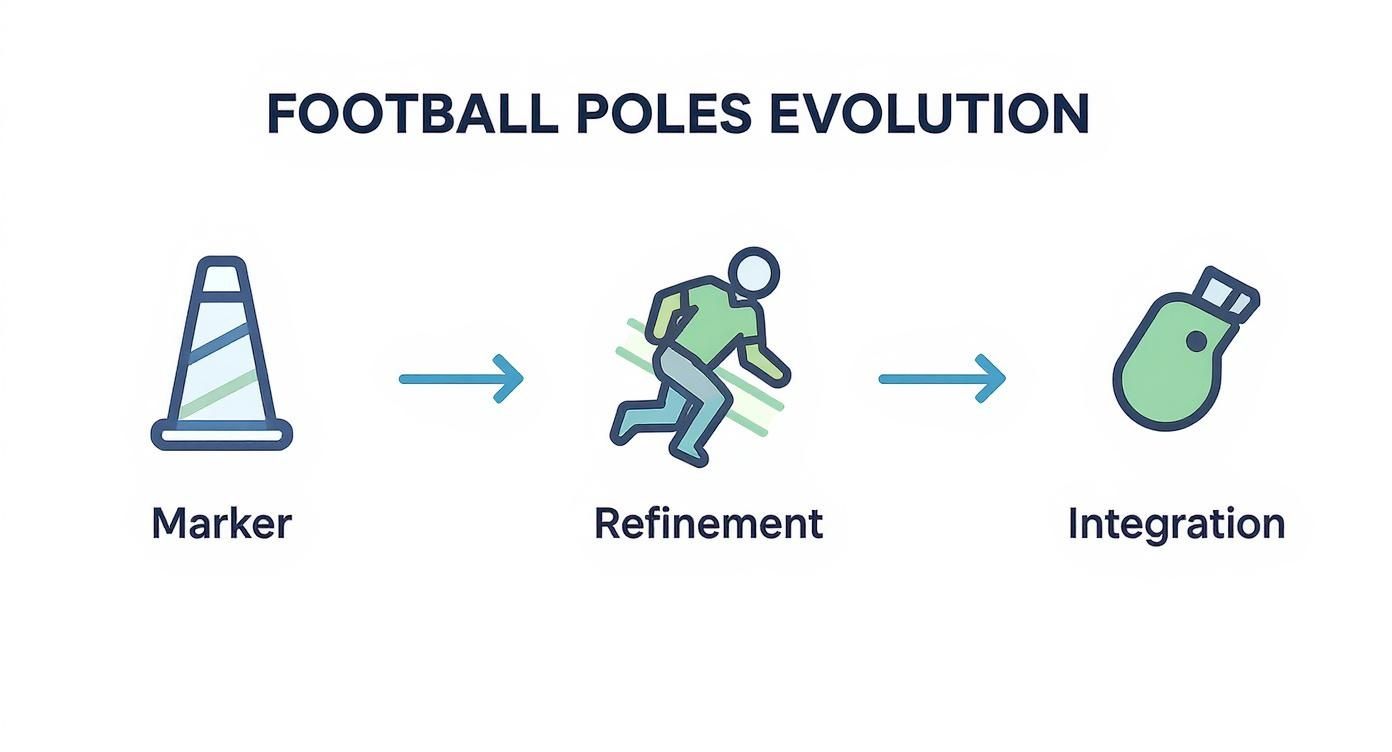In the world of football, agility is the currency of success, and few tools sharpen this skill quite like a set of football training poles. These simple-looking sticks are the unsung heroes of the training pitch. Think of them as static defenders, forcing players to nail those quick changes of direction, tight ball control, and crucial spatial awareness. They are fundamental for building the sharp, reflexive movements that make top players so hard to mark.
Why Training Poles Are a Player's Secret Weapon

Imagine a training ground populated by tireless, perfectly positioned opponents who never get beaten. That is the role football training poles play. They are not just plastic markers; they’re a dynamic tool designed to mimic the tight spaces and defensive pressure you face in a real match. Weaving through them forces you to think and move faster.
This constant challenge helps to build muscle memory for the rapid footwork and body control needed to dodge tackles and create scoring chances. The poles act as physical obstacles, teaching players how to manoeuvre with the ball at their feet when the pitch gets crowded.
Developing Core Footballing Skills
The main job of training poles is to improve a player's agility and coordination. Slaloming or zigzagging through a line of them forces constant adjustments in speed and direction, which translates directly to better decision-making on match day.
However, it is not just about movement. They significantly sharpen other key abilities, too:
- Close Control: Dribbling through poles demands the ball stays glued to your feet, refining touch and control under pressure.
- Spatial Awareness: You have to constantly judge distances and angles to get through the poles cleanly, which improves your ability to operate in tight spaces.
- Balance and Coordination: The quick, sharp turns required for pole drills build core stability and overall body coordination.
At its core, agility training with poles is not just about moving quickly—it's about moving efficiently. It teaches players to decelerate, turn, and accelerate explosively, all while keeping complete control of the football.
Whether you're an academy prospect or a Sunday league hopeful, adding poles to your routine builds the foundational skills that separate good players from great ones. For a complete look at other essential gear, explore our full range of football training equipment at SoccerWares.
Choosing the Right Poles for Your Pitch and Drills

Picking the right football training poles is not just a minor detail—it is a decision that shapes how effective and safe your drills are. Think of it like a golfer choosing a specific club for a particular shot. A coach needs the right tool for the job, and not all poles are created equal.
The market is full of different models, each built for specific drills and training grounds. Your choice comes down to the intensity of your sessions and, crucially, the surface you train on. Getting it wrong can mean damaged equipment, wasted practice time, or even putting players at risk.
Rigid vs Spring-Loaded Poles
The biggest difference you will find is between standard rigid poles and their spring-loaded cousins. Rigid poles are like static defenders—perfect for marking out channels, setting up gates, or for slower, more technical weaving drills where precision is everything. They are solid, simple, and usually easier on the wallet.
But when you ramp up the intensity with high-speed dribbling and explosive agility work, spring-loaded poles are in a league of their own. They have a coiled spring at the base that lets the pole bend on impact and snap right back into place.
This clever design gives you two massive wins:
- Player Safety: It significantly reduces the risk of injury if a player collides with one during a fast-paced drill.
- Equipment Durability: That flex means they’re far less likely to snap or break, giving them a much longer lifespan.
For any session involving explosive changes of direction or aggressive attacking runs, spring-loaded poles give you the resilience to train at match-day intensity.
Matching the Base to Your Surface
Just as vital as the pole is the base it sits on. The type of pitch you are using is the deciding factor here, and it is a detail you cannot afford to get wrong. Using the wrong base will not just be useless; it could seriously damage the playing surface.
-
Spiked Bases: These are built for one thing: natural grass pitches. The metal spike digs firmly into the soil, giving you rock-solid stability that will not budge in high winds or from an accidental knock. Never use these on artificial turf, 3G/4G pitches, or indoor courts. It will tear them to shreds.
-
Weighted Rubber or Fillable Bases: For any artificial surface or indoor hall, you need a heavy base that will not pierce the ground. These are usually solid rubber or hollow plastic containers you can fill with sand or water for weight. They provide a stable foundation without causing any damage.
By thinking carefully about both the pole type and its base, you can ensure your football training poles are perfectly matched to your drills and your ground. To see how different pieces of kit can work together, take a look at our complete guide to football training equipment.
How Poles Became a Staple of Modern British Football
It is hard to imagine a training ground without them now, but the humble football training pole was not always a fixture on British pitches. For decades, coaching in the UK was all about grit, physical strength, and stamina. The training pitch was for running laps and playing full-sided matches, and cones were pretty much the only tool you would see.
However, things started to change towards the end of the 20th century. A new generation of British coaches, inspired by the fluid, technical style of continental European teams, began to champion agility, close control, and quick decision-making. The old ways were making way for a smarter, more scientific approach to player development.
A New Coaching Philosophy Emerges
This shift in mindset created a need for better tools. Coaches quickly realised that to build technically gifted players, they needed equipment that could properly challenge and fine-tune specific movements. Cones were fine for marking out a square, but they could not replicate a defender or force a player to weave and turn with precision.
This is where football training poles found their calling. They were the perfect fit for this new coaching doctrine, offering a simple but incredibly effective way to design drills focused on:
- Simulating Opponents: Forcing players to navigate around them as if they were real defenders.
- Forcing Directional Changes: Encouraging sharp, rapid shifts in movement with the ball at their feet.
- Improving Spatial Awareness: Teaching players how to operate in congested areas of the pitch.
From Academies to Grassroots Pitches
It was the Premier League academies that first fully embraced poles, integrating them into their daily regimes. They became a cornerstone of youth development, used to drill the sharp, evasive movements that define modern attacking football. It was not long before the success at the top level trickled down.
Soon enough, grassroots clubs and local teams across the country adopted them, seeing just how valuable they were for building core skills. The numbers back this up. Surveys from the early 2000s showed that over 85% of professional academies in England were using poles in their drills. A 2015 study also found that over 70% of grassroots clubs saw a noticeable improvement in player skills after adding poles to their sessions. You can discover more about the history of football training technology to see how these tools evolved alongside coaching.
Today, the sight of players slaloming through a set of brightly coloured poles is a sign of a modern, effective training session. They are no longer just an accessory but a fundamental piece of kit, reflecting a national commitment to developing smarter, more agile footballers at every level of the beautiful game.
Setting Up Your First Agility Pole Drills
Getting started with football training poles is a lot simpler than you might think. The goal is not to create a complex maze right away. It's about laying out patterns that challenge a player's agility, balance, and control, starting with the basics and building up from there. Mastering the fundamentals is where you will see the biggest improvements.
The secret to a good drill is consistency, especially with pole spacing. A solid rule of thumb is to place poles 2 to 3 metres apart for most dribbling drills. This gives just enough room for players to move the ball cleanly but is tight enough to demand quick feet and sharp reactions.
The Foundational Straight-Line Slalom
The first and most important setup is the straight-line slalom. This is the bedrock of agility pole training, stripping everything back to focus purely on close control and rhythmic, fluid movement. It is the perfect drill for a warm-up or for any player just getting used to this kind of training.
Simply place between 6 and 10 poles in a single straight line. The player then weaves in and out, alternating which foot they use to guide the ball around each pole. A key coaching point here is to encourage players to keep their heads up as much as possible, using their peripheral vision to navigate the course rather than staring down at the ball.
The infographic below shows just how far these simple tools have come, evolving from basic markers into a sophisticated part of modern coaching.

This visual journey highlights that what started as a simple way to mark out space is now an essential tool for developing precise, agile, and game-ready players.
Progressing to Zigzag and Gate Patterns
Once a player gets comfortable with the straight-line slalom, it’s time to up the ante with drills that force sharper changes of direction. This is where zigzag and gate patterns come in, as they start to mimic the unpredictable, stop-start movements of a real match.
-
The Zigzag: Instead of a straight line, just offset each consecutive pole by a metre or two to the side. This simple change forces players to make a distinct, sharp cut around each one. It is a fantastic test of their ability to decelerate, turn, and accelerate away quickly, all while keeping the ball under close control.
-
The Gate: Set up pairs of poles about a metre apart to create a series of "gates." The challenge is for players to dribble through each gate. You can arrange these gates in a straight line for consistency, in a curve to work on turning, or in a random pattern to test their decision-making and dribbling precision under pressure.
The real magic of these drills is in teaching players how to shift their body weight effectively. A good change of direction is less about raw speed and more about balance—dropping the shoulder, using your arms, and exploding away from the pole just like you would to beat a defender.
By mastering these core setups, you build a brilliant foundation for more advanced and creative exercises. If you're looking for more ideas to get started, our guide on beginner soccer drills has plenty of exercises that can be easily adapted using training poles.
Unlocking Advanced Training Techniques
For seasoned players and coaches, football training poles are so much more than just slalom markers. Once you’ve nailed the basics, they become an incredible tool for mimicking the chaos and pressure of a real match. The real magic happens when you start blending pole drills with other key footballing actions.
Simple slalom runs are great for control, but advanced drills need to add a layer of game-like decision-making. Do not just weave through them—make sure every drill ends with a purpose. This forces players to get their heads up, scan what is around them, and pull off a technical skill right after navigating a tight spot.
Combining Agility with Match-Specific Actions
To really challenge your players, start mixing agility patterns with functional football skills. This is how you connect physical sharpness with mental speed—the very essence of what makes a top player.
Here are a couple of drills to get you started:
- Slalom to Pass: The player dribbles through a zigzag pole setup then has to immediately fire off a weighted pass to a moving teammate or a small target. This is brilliant for teaching players how to create a yard of space and then deliver an accurate ball while still off-balance.
- Obstacle to Shot: Instead of a neat line, scatter several poles randomly in front of the goal. The player has to navigate these 'defenders' before unleashing a first-time shot. It's a perfect simulation of a breakaway where a quick finish is everything.
These drills work so well because they copy the exact sequence of a match: beat a player, then make the next vital move. The speed at which a player can switch between those two actions is what separates the good from the great. If you want to dive deeper into building that explosive power, check out our guide on how to increase speed.
Using Poles for Tactical and Team Drills
It is not all about individual skill, though. Football training poles are invaluable for coaching team tactics and boosting football IQ. You can use them to map out defensive shapes, passing lanes, and pressing triggers without needing a full opposition team on the pitch.
For coaches, poles become a tactical whiteboard on the pitch. They provide clear visual cues for players, helping them understand positioning, movement, and the timing of their actions within the team’s system.
Clubs and academies tied to the English Football League (EFL) use poles all the time for team drills, especially for working on positioning and pressing formations. In fact, feedback from FA coaching programmes in 2021 showed that over 67% of recommended technical drills use poles to simulate opponents and sharpen decision-making. This method lets coaches install complex tactical ideas in a controlled, repeatable way, turning a simple bit of kit into a powerful coaching weapon.
Common Questions About Football Training Poles
As you start thinking about adding football training poles to your sessions, a few practical questions always pop up. This section gives you clear, straightforward answers to the most common queries, helping you invest wisely and get the most out of your new gear from day one.
Think of this as your final pre-match briefing—making sure you have all the information you need before you step onto the training pitch. We will cover everything from how many to buy to which type is right for your surface.
How Many Training Poles Do I Actually Need?
For individual players or small groups, a set of 8 to 12 poles is a fantastic starting point. It is more than enough to set up effective slaloms, gates, and zigzag patterns without cluttering your training area.
If you are a coach running full team sessions, you will probably want 16 to 24 poles on hand. This lets you run multiple drills at the same time or create bigger, more complex patterns that can get the whole squad involved.
Are Spring-Loaded Poles Worth the Extra Cost?
They absolutely are—if you are focusing on high-intensity, high-speed drills. Spring-loaded poles bend on impact and snap right back into place. This is a lot safer for players moving at pace and drastically reduces broken equipment over time.
For simply marking out areas or for slower-paced technical work, standard rigid poles are perfectly fine and much easier on the wallet. The right choice really comes down to your training intensity and priorities.
In short: for explosive agility work, the spring-loaded option is a smart investment in both player safety and gear longevity. For foundational drills, rigid poles do the job perfectly well.
Can I Use Spiked Poles on Artificial Turf?
No, you should never use spiked poles on artificial turf, 3G pitches, or any indoor surface. The spikes will tear up the pitch and cause permanent damage.
For these surfaces, you need poles designed to fit into heavy rubber or water-fillable bases. They provide all the stability you need without wrecking the ground. Many modern sets from retailers like SoccerWares come with interchangeable options or are sold specifically for all-surface use.
Ready to take your agility and control to the next level? Explore the full range of high-quality football training poles and other essential gear at SoccerWares. Find the perfect equipment to build your skills today at https://soccerwares.com.

